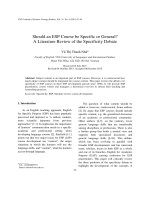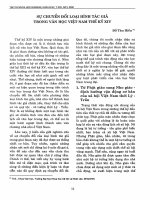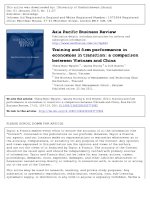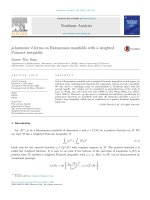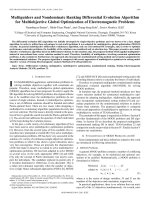DSpace at VNU: Should an ESP Course be Specific or General? A Literature Review of the Specificity Debate
Bạn đang xem bản rút gọn của tài liệu. Xem và tải ngay bản đầy đủ của tài liệu tại đây (115.91 KB, 9 trang )
VNU Journal of Science: Foreign Studies, Vol. 31, No. 4 (2015) 37-45
Should an ESP Course be Specific or General?
A Literature Review of the Specificity Debate
Vũ Thị Thanh Nhã*
Faculty of English, VNU University of Languages and International Studies,
Phạm Văn Đồng, Cầu Giấy, Hà Nội, Vietnam
Received 02 July 2015
Revised 06 October 2015; Accepted 08 October 2015
Abstract: Subject content is an important part of ESP courses. However, it is controversial how
much subject content should be integrated into course content. This paper reviews the debate over
specificity of ESP courses in three ESP development periods since 1960s. It will provide ESP
practitioners, course writers and managers a theoretical overview to inform their teaching and
researching practices.
Keywords: Specificity, ESP, literature review, course development.
1. Introduction*
The question of what content should be
added is, however, controversial. Some authors
[2] [3] argue that ESP courses should include
specific content, e.g. the specialized discourses
of an academic or professional community.
Other authors [4-7], on the contrary, favor
generic language skills that are transferable
among disciplines or professions. There is also
a further group that holds a neutral view and
supports both specialized discourses and
generic language skills [8-10]. This debate,
which has been evolving in parallel with
broader ESP developments and has interested
many scholars, incurs in both ESP as a whole
and one of its branches, English for Academic
Purpose (EAP), causing confusion for ESP
practitioners. This paper will critically review
the three positions of the specificity debate to
highlight the development of the concepts. It
As an English teaching approach, English
for Specific Purpose (ESP) has been popularly
perceived and depicted as “a radical, modern,
more scientific departure from previous
approaches” [1:1]. It emphasizes the importance
of learners’ communication needs in a specific
academic and professional setting when
developing language courses [2]. Starfield [1:1]
points out that two major issues for ESP (LSP)
course development are “context”, the target
situations in which the learners will use the
language skills, and “content”, what the learners
access through language.
_______
*
Tel.: +84466805931
Email:
37
38
V.T.T. Nhã / VNU Journal of Science: Foreign Studies, Vol. 31, No. 4 (2015) 37-45
will provide a theoretical framework for
English language teachers in ESP course design
and material developments to undertake further
empirical studies in their own teaching
contexts.
The following sections will trace the
trajectory of the specificity debate over three
periods: 1960s-1970s, 1980s, and from 1990s to
present.
2. Specificity debate in the 1960s and 1970s
In 1960, the term English for Special
Purpose was first introduced in the Makerere
Conference [11]. The word Special refers to the
special needs of a group of learners, which
could be identified via “detailed studies of
restricted language and special registers” from
“large samples of the language used by the
particular person concerned.” [12:1]. This
specialized focus was, in fact, one of the great
attributes of ESP compared to the focus on
General English at the time. Many studies were
conducted to identify the special linguistic
needs of learners’ target situations. Examples
include Herbert [13], Ewer and Latorre [14],
Huddlestone [15], and Ewer and HughesDavies [16]. However, Starfield [1] notes that
these studies were subsequently criticized for
being confined to sentence level, offering
unauthentic reading materials, being overly
focus on forms, and overlooking the fact that
lexical and grammatical structures could be
found in more than one register. In response to
the criticism, researchers focused on
characterizing language functions and notions
in one area and beyond sentence-level [17-20].
Other authors conducted whole text analysis
with sample texts from the learners’ fields of
study or work [17].
The underlying educational rationale for
this movement was that language learning is
more effective and more motivating if the
program content is relevant to learners’
particular field of need or interest [21-23]. Also,
the ability to use general language is not as
important as the effective use in specific areas
relevant to the learners’ needs and interests.
Students’ needs are thus equated with the
linguistic demands in their chosen field. In this
early stage, an ESP course with highly
specialized materials was a markedly popular
choice.
3. Specificity debate in the 1980s
The subsequent decade saw a new phase of
thinking, where ESP was not considered as
confined only to target situation language
needs. It expanded its concern to the learners
and the learning process in the present
conditions of learning [11]. Therefore, highly
specialized ESP courses became less favored
than general ESP courses. Hyland [2] attributes
this change to two major factors, theory-related
and
administration-related.
Theoretically,
generic ESP courses are based on the position
that literacy can be “taught to students as a set
of discrete, value-free rules and technical skills
usable in any situation” [2: 386-387].
Regarding the administrative side, general ESP
courses are “cheaper, logistically undemanding,
and require less skilled staff to implement” [2:
387].
Hutchinson and Waters [6], for example,
strongly favor general linguistic competence
compared to specialized discourse knowledge
in ESP courses. They argue that a native
English student will be able to cope with new
knowledge in any technical area of study
V.T.T. Nhã / VNU Journal of Science: Foreign Studies, Vol. 31, No. 4 (2015) 37-45
regardless of the fact that he/she does not have
“any knowledge of either the subject itself, or
the specific terms associated with it” [6: 178].
Their proposed explanation is the existence of
“a basic Underlying Competence that, largely
irrespective of subject, enables the student to
interpret the flow of new knowledge” [6: 178].
It is this underlying competence, which is
“fundamental” because it is the “starting point”
of teacher and student interactions in learning
new knowledge [6: 178]. In their later work
[24], English for Specific Purposes: A learnercentered approach, Hutchinson and Water
advocate a more neutral stance towards
specialized materials. On the one hand, they
claim that language variations for each
discipline are not sufficient. They write: “There
is no grammatical structure, function or
discourse structure that can be identified
specifically with Biology or any particular
subject.” [24: 165]. Therefore, there is “little
linguistic justification for having highly
specialized texts” [24: 161]. On the other hand,
Hutchinson and Waters [24] acknowledge the
“face validity” of highly specialized texts in
ESP courses, such as making learners
“motivated” and the language “more relevant”
[24: 161]. They conclude that the choice of ESP
materials should be considered in the
learning/teaching process and in relation to
other factors such as the teachers’ “knowledge
and competence” [24: 162].
Similarly, Bloor and Bloor [25] develop a
Common Core Hypothesis, which proposes the
existence of linguistic features that can be
found in many varieties. The common core
consists of skills like “summarizing,
paraphrasing, quoting” [7: 43] or topics of
“persuasive language” such as “expressing
cause and effect” [2: 389]. The weaknesses of
the hypothesis are how to identify the core and
39
that “it focuses on the formal system and
ignores the fact that forms has different possible
meanings depending on the contexts in which it
is used” [2: 389].
Blue [26] supports ‘general ESP’ by
separating English for General Academic
Purposes (EGAP) from English for Specific
Purposes (ESAP). The former focuses on skills
that are transferable to various academic
disciplines such as listening and note-taking,
reference skills, and participating in seminars
and discussions. The latter, in contrast,
prioritizes language and communicative needs
which are stable and typical in a particular
discipline (e.g. law or economics).
This
classification has shaped two approaches for
designing EAP courses. The wide-angled (or
general) approach favors EGAP while the
narrow-angled (or specific) one takes up ESAP.
Unlike other authors, Spack [7] is more
concerned with the administration of
specialized ESP courses. She examines the
situation in which English teachers have to
teach disciplinary writing, specifically Writing
Across the Curriculum for L1 learners and ESP
writing for L2 learners. She believes that each
discipline has its own conventions, “a different
system for examining experience, a different
angle for looking at subject matter, a different
kind of thinking” [7: 38]. Therefore, she claims
that teaching writing in the discipline is a
demanding job because it “involves even more
specialized knowledge and skills than does the
teaching of the subject matter itself” [7: 38].
She concludes that it is preferable for writing to
be taught by subject teachers who have “a solid
grounding in the subject matter and who have
been through the process themselves” [7: 40].
The “traditional” and “worthy” role for the
English teacher is to teach generic issues such
as “general inquiry, strategies, rhetorical
40
V.T.T. Nhã / VNU Journal of Science: Foreign Studies, Vol. 31, No. 4 (2015) 37-45
principles, and tasks that can transfer to other
course work” [7: 40-41].
To summarize, in the 1980s, the concept of
specificity was challenged when more attention
was given to the learning situation and learners'
transferable skills. Wide-angled approach was
supposed to be against the narrow-angled
approach of specificity, which was prevalent in
the 1960s and 1970s.
4. Specificity debate from 1990s to present
In the early 1990s, ESP courses were
developed based on the needs of both target
situation and present situation, an “integrated
scope” of needs analysis [11: 1]. It is interesting
that a number of studies focused particularly on
registers and the discourses of different
disciplines during this period [27] [1]. Starfield
[1] called it a “resurgence of interest” (p.3) in
register analysis due to the invention of new
software. The debate of specificity, therefore,
became more complex than ever. This section
will discuss three dominant arguments: highly
specific, generic, and combined.
At one extreme of the specificity debate,
Hyland [2] argues strongly for a highly subjectspecific course. He writes: “ESP must involve
teaching the literacy skills which are
appropriate to the purposes and understandings
of particular academic and professional
communities.” (p.386). On the one hand, he
criticizes the wide-angle perspectives, which he
thinks, “undermine our pedagogic effectiveness,
weaken our academic role, and threaten our
professionalism” (p.387). He points out several
reasons for this argument. For example, general
ESP might not meet “students’ urgent needs”
(p.388) to work effectively in the discipline,
due to its focus on the universal principles of
inquiry or rhetoric that remains difficult to
identify. Second, it operates on a false
assumption of how students learn. Students
“acquire features of the language as they need
them” rather than in “a step-by-step” fashion
(p.388), from common core for weak students
to more specific and difficult language features
as students advance. Third, specialist discourses
should not be left to subject specialists who
“generally lack both the expertise and desire to
teach literacy skills” (p.388). Last, the cost for
specialized ESP, which is research-based,
effective, and close to the work settings, is a
value-for-money investment.
On the other hand, he confirms the
existence of multiple subject-specific literacies
as a strong theoretical foundation for a narrowangled ESP approach and some related research
approaches, e.g. genre study and text analysis.
He writes: “Disciplines have different views of
knowledge, different research practices, and
different ways of seeing the world, and as a
result, investigating the practices of those
disciplines will inevitably take us to greater
specificity” (p.389). One important feature of
discipline variation he highlights that scholarly
discourses are differentiated as “an outcome of
a multitude of practices and strategies” of a
specific community to develop arguments,
instead of by “merely specialist topics and
vocabularies” (p.391). As a result, he calls for
the application of specific (narrow-angled) ESP
courses “as far as we can” [2: 394] to assist
students to learn new literacy skills and
participate in a particular academic or cultural
setting.
Hyland’s [2] work had substantial influence
on subsequent writings on specificity,
especially those from authors at the other
extreme of the debate such as Dovey [5];
Huckin [28] and Anthony [4], who take the
V.T.T. Nhã / VNU Journal of Science: Foreign Studies, Vol. 31, No. 4 (2015) 37-45
position of wide-angled approaches.
For
example, Huckin [28] responds positively to
Hyland’s ‘appeal’ to provide more specialized
ESP. However, Huckin doubts the possibility
that ESP teachers can “jump in and provide
narrow angle expertise” and Hyland’s ruling out
of the existence of a “transdisciplinary common
core of features” (p.8). He also criticizes
Hyland’s [2] concept of specificity as teachercentered and “content-based” (p.9). In contrast,
he proposes that “specificity should be defined
not in terms of content per se but in terms of the
learner and his or her needs” [28: 10, italic
from the original]. An implication for teachers
is to teach “strategies” such as “learning
strategies” and “rhetoric strategies” (p. 11) and
rely on students to supply specificity from their
own disciplines.
Similarly, Dovey [5] advocates teaching
attributes transferable from university to
workplace, including “the ability to learn fast
and learn how to learn” (p.396) and “the ability
to communicate effectively with colleagues and
managers” (p.391) in the context of the
knowledge economy. She points out the
limitations of the traditional discipline-specific
approach, which is strongly supported by
Hyland [2]. These include an assumed ability to
identify and teach genres for “the relatively
homogeneous purpose” [5: 388] which can be
defined for any context; and a narrow concept
of
transferability.
She
explains
that
“transferability tends to be considered mainly
from the perspective of what is transferable
from generic classes to disciplinary contexts, or
what can be ‘reliably and usefully’ transferred
‘across disciplines’ (Hyland & Hamp-Lyons,
2002, p. 7)''. It is traditionally assumed that
learning and literacy achieved in academic
contexts are transferable to professional
contexts. In fact, it is not always the case,
41
because “there are clearly significant
differences between the workplace-like genres
produced for the purposes of assessments, and
the authentic workplace genres” [5: 395] in
terms of purpose and nature. In addition, hybrid
assessment tasks “are constantly evolving, and
do not settle into the stable patterns which
would allow them to be classified as a genre at
all” [5: 397]. She also raises the issue that
traditional literacy is “almost invariably
conflated with reading and writing” (p.400),
which might exclude oral communication and
interactions as essential social practices in the
new knowledge era.
Anthony [4] continues to advocate for
general/wide-angled
ESP
by
critically
examining the intertwined relationships of
products, processes, and practitioners. She
argues that the general process-oriented
approach equips students with skills which are
“highly valued in the modern workplace” (p.3)
while the product-oriented approach towards
more specialized ESP limits students’
adaptability into the workplace due to the rapid
evolution of the target product. In addition, the
product-oriented approach puts “a great burden
on ESP practitioners” (p.6) in an “idealized”
(p.7) situation. As a result, in reality, ESP
teachers might use inappropriate commercial
ESP textbooks or completely turn away from
ESP to focus on TOEFL or TOEIC preparations
[4]. Although she agrees that specialist subject
areas are “highly variable” (p. 10), Anthony
suspects that the variations of language forms
and practices are, however, sufficiently stable
and “discipline-defining” (p.10) to be relayed to
learners. She writes:
“A related point is that the differences
between disciplines should more accurately be
described as probabilistic variation in central
42
V.T.T. Nhã / VNU Journal of Science: Foreign Studies, Vol. 31, No. 4 (2015) 37-45
core elements rather than deterministic rules
(Halliday, 1991)” [4:11].
Among authors of combined stance, Johns
[1990, cited in 29] and Dudley-Evans and St
John [10] develop Blue’s [26] concepts of
EGAP and ESAP and point out situations to
apply them. In the context of ESP in the USA,
Johns [29] classifies EGAP for undergraduate
students who are entering academia while
ESAP is for graduate students with greater
expertise in the field. Meanwhile, DudleyEvans and St Johns[10] relate specificity to a
continuum of learners’ language proficiency.
Beginners commence with general English
courses and progress to more specific courses
when their English is improved. In their
classification, EGAP refers to courses on
“common-core language and skills that are not
related to specific disciplines or professions”,
followed by a more specific course type on
“broad disciplinary or professional areas” [10:
9]. They also acknowledge that “the commoncore EAP work makes more sense and is more
relevant if it is supplemented by specific work”
[10: 42]. This continuum, however, seems to
have limited application as it requires students
with a “certain level of English proficiency” [8:
59]. In fact, as Bloor and Bloor [1986, cited in
[8], p.59-60] argue, students can acquire a
common core of English through “being
exposed to any variety of English”. In addition,
they will be able to learn “form-function
relationship in the specialist area” [8: 59].
Therefore, Basturkmen [8] suggests a modified
version of the wide-angled approach, which
introduces common core through a variety of
English. The texts may come from a group of
sub-varieties to include a “congrometrition” [8:
60], highlighting language items that are used
more frequently in that variety. However, it is
open for teachers and course designers to
decide which items should be included.
Similarly, Clapham [9] examines the effects of
background knowledge on EAP students’
reading performance. She recommends that
EAP teachers should introduce general
academic texts with common-core rhetoric
functions meanwhile some functions require
specific texts, which need to be checked for
their appropriateness by the teachers.
Recently, Huhta, Vogt, Johnson, and Tulkki
[30] highlight the hybrid nature of specific
content in their definition of professional
context specificity. They look at a learner as a
whole person with complicated social roles.
They, therefore, argue that traditional domain
specificity, which was based on language
specific features in a professional domain, fails
to include communication events a learner may
encounter outside their professional domain.
For example, an accountant working in
healthcare may need medical terms. An
interdisciplinary content might be identified to
meet the learner's needs in a professional
context.
In summary, the specificity debate since
1990s seems to contextualize the concept of
specificity to accommodate specific learners'
needs. It is the learners who will determine how
specific the content should be. With a diversity
of social roles, the content might be
interdisciplinary rather than domain specific.
5. Conclusion
The discussion so far highlights that it is
controversial how specific an ESP course
should be. On the one hand, specialized ESP (a
narrow-angled or product-oriented approach) is
supported for its pedagogical effectiveness,
needs-based
approach,
and
workplace
V.T.T. Nhã / VNU Journal of Science: Foreign Studies, Vol. 31, No. 4 (2015) 37-45
orientation on the assumption that disciplinary
or occupational language variations can be
identified and taught [2] [3]. However, it is
criticized for its increased workload for ESP
practitioners [4] [7] limited transferability [4]
[5], and the unclear existence of identifiable and
stable subject variations [4] [6]. Therefore, an
increasing number of authors turn to general
ESP (a wide-angled or process-oriented
approach) which focuses on a common core of
languages, generic and transferable skills and
greater feasibility for ESP practitioners [4-7]. In
addition, other authors attempt to maximize the
strengths and compromise the weaknesses of
the two approaches by listing conditions for
each approach [10] and Johns (1990, cited in
[29]), by integrating specialized materials into
general ESP courses [8] or by identifying
communicative events learners need in their
professional context [30].
The debate also reflects the dynamic
evolution of some important concepts such as
common
core,
disciplinary
variations,
transferability, and transferable skills. However,
there are various sources of confusion. Firstly,
these studies use mixed examples and draw
arguments from either ESP or EAP, which
might be invalid or irrelevant to both. Even
though they are closely related, EAP differs
from ESP in terms of its target situation, the
academic environment instead of the
workplace. Thus, it is likely that EAP teachers
are more experienced than students who are
taking an EAP course prior to their disciplinary
subjects, which is not necessarily the case for
ESP.
In addition, the particular contexts of the
ESP courses in the studies tend to be
ambiguously addressed. In fact, Dudley-Evans
and St John [10: 35] point out four different
contexts in which ESP courses could be
43
implemented in relation to students’ first
language and their experience in English
medium environments. These features, as they
argue, might influence the research focus and
problems addressed in EAP. For example, in
English-speaking countries, the focus of EAP
courses is “the academic language” and “study
skills” related to the main skills such as
academic reading or writing [10: 36]. In
contrast, in ESL contexts, it is shown that EAP
students have a mixture of needs for taking
English-medium courses and developing
communication skills for work (Williams,
Swales & Kirkman, 1984 as cited in [10]). In
addition, the common-core study skills courses
seem to be less motivating to students in ESL
situations who have high language proficiency
(Chukwuma et al, 1991; Monsi et al, 1995; and
Obah, 1993 as cited in [10]). Starfield [12],
therefore, suggests using subject-specific
courses to motivate students in the ESL
educational setting. Meanwhile, in EFL
situations, many EAP courses prepare students
to adjust from the national language medium at
secondary level to English medium at tertiary
level. Students have “a much lower level of
English” and the subject course might be
delivered in “a mixture of English and the
national language” [10: 39].
Finally, several of these studies lack
empirical evidence to support their arguments.
Few studies have been done to find out which
approach is preferred and why it is selected
from the teachers’ and students’ perspectives.
Dovey [5], for instance, admitted that her
proposals “raise questions rather than attempt to
provide answers by way of empirical research”
(p.389). Even Huckin [28] who emphasizes the
centrality of learners’ needs fails to introduce
students’ voices into his arguments.
44
V.T.T. Nhã / VNU Journal of Science: Foreign Studies, Vol. 31, No. 4 (2015) 37-45
Therefore, there is a pressing need to seek
empirical evidence of how ESP practitioners
interpret the concepts in their local practices.
Various factors should also be considered such
as the overall purpose of the language program,
students' language proficiency, outside-theclassroom language, the length of the course,
and resources (teacher and expertise). It is
essential that the course implementers, such as
teachers and students, hold a shared meaning of
course specificity to ensure the alignment of
goals and classroom practices [31] and students'
interest.
[10]
[11]
[12]
[13]
[14]
[15]
References
[1] Starfield, Sue. "Historical Development of
Language for Specific Purposes." In Encyclopedia
of Applied Linguistics edited by Carol A.
Chapelle, 1-6: Blackwell Publishing Ltd, 2013.
[2] Hyland, K. "Specificity Revisited: How Far
Should We Go Now?" English for Specific
Purposes 21, no. 4 (2002): 385-95.
[3] Paltridge, Brian. "Systems of Genres and the Eap
Classroom." TESOL Matters 1, no. 12 (2000).
[4] Anthony, Laurence. "Products, Processes and
Practitioners: A Critical Look at the Importance of
Specificity in Esp." Taiwan International ESP
Journal 3, no. 2 (2011): 1-18.
[5] Dovey, T. "What Purposes, Specifically?
Rethinking Purposes and Specificity in the
Context of the 'New Cocationalism'." English for
Specific Purposes 25, no. 4 (2006): 387-402.
[6] Hutchinson, Tom, and Waters, Alan. "Esp at the
Crossroads." In English for Specific Purposes.
Corvallis: Oregon State University, 1980.
[7] Spack, R. "Initiating Esl Students into the
Academic Discourse Community: How Far
Should We Go?" TESOL Quarterly 22, no. 1
(1988): 29-51.
[8] Basturkmen, Helen. "Specificity and Esp Course
Design." RELC Journal 34, no. April (2003): 4863.
[9] Clapham, Caroline. "Discipline Specificity and
Eap." In Perspectives on English for Academic
Purposes, edited by John Flowerdew and Matthew
[16]
[17]
[18]
[19]
[20]
[21]
[22]
[23]
[24]
[25]
Peacock, 84-100. Cambridge: Cambridge
University Press, 2001.
Dudley-Evans, T., and M.J. St John.
Developments in Esp: A Multi-Disciplinary
Approach. 2nd ed. Cambridge: Cambridge
University Press, 1998.
West, Robert. "Needs Analysis in Language
Teaching." Language Teaching 27, no. 1 (1994):
1-19.
Starfield, Sue. "Cummins, Eap, and Academic
Literacy." TESOL Quarterly 28, no. 1 (1994):
176-79.
Herbert, A.J. The Structure of Technical English.
London, England: Longman, 1965.
Ewer, J. R., and G Latorre. A Course in Basic
Scientific English. London, England: Longman,
1969.
Huddlestone, R. The Sentence in Written English.
Cambridge: Cambridge University Press, 1971.
Ewer, J. R., and Hughes-Davies. "Further Notes
on Developing an English Programme for
Students of Science and Technology " English
Language Teaching 26, no. 1 (1971): 65-70.
Lackstrom, J.E., L. Selinker, and L. Trimble.
"Technical Rhetorical Principles and Grammatical
Choice." TESOL Quarterly 7 (1973): 127-36.
Munby, J. Communicative Syllabus Design, 1978.
Cambridge: Cambridge University Press, 1978.
van Ek, J.A. Systems Development in Adult
Language Learning: The Threshold Level.
Strasbourg: The Council of Europe, 1975.
Wilkins, D. Notional Syllabuses. Oxford: Oxford
University Press, 1976.
Brindley, G. "The Role of Needs Analysis in
Adult Esl Program Design." In The Second
Language Curriculum. , edited by R.K. Johnson,
63-78. Cambridge: Cambridge University Press,
1989.
Flowerdew, Lynne. "Needs Analysis and
Curriculum Development in Esp." In Handbook of
English for Specific Purposes, edited by B.
Paltridge and S. Starfield, 325-46. West Sussex:
UK: Wiley -Blackwell, 2013.
Nunan, D., and Clarice Lamb. The Self-Directed
Teacher: Managing the Learning Process.
Cambridge: Cambridge University Press, 1996.
Hutchinson, Tom, and Waters, Alan. English for
Specific Purposes: A Learning-Centred Approach.
Cambridge: Cambridge University Press, 1987.
Bloor, M., and T. Bloor. Language for Specific
Purposes: Practice and Theory. Dublin: Trinity
College, 1986
V.T.T. Nhã / VNU Journal of Science: Foreign Studies, Vol. 31, No. 4 (2015) 37-45
[26] Blue, G.M. "Individualising Academic Writing
Tuition." In Academic Writing: Process and
Product. Elt Document 129, edited by P.C.
Robinson, 1988.
[27] Paltridge, Brian. "Afterword: Where Are We Now
and Where Have We Come From?" In English for
Specific Purposes in Theory and Practice, edited
by D. Belcher, 289-96. Ann Arbor: University of
Michigan Press, 2009.
[28] Huckin, Thomas. "Specificity in Lsp." IBÉRICA
(2003),
/>
45
[29] Robinson, Pauline. Esp Today: A Practitioner's
Guide. Edited by Christopher N. Cardin,
Language Teaching Methodology. London:
Prentice Hall, 1991.
[30] Huhta, Maratta, Karin Vogt, Esko Johnson, and
Heikki Tulkki. Needs Analysis for Course Design:
A Holistic Approach to Esp. Edited by David R.
Hall. Cambridge: Cambridge University Press,
2013.
[31] Mahboob, Ahmar, and Namala Tilakaratna. "A
Principles-Based Approach for English Language
Teaching Policies and Practices." California:
USA: TESOL International Association, 2012.
Khóa học tiếng Anh chuyên ngành nên có nội dung
chuyên sâu hay phổ quát? Tổng quan về ý kiến tranh luận
xung quanh kiến thức chuyên ngành trong ESP.
Vũ Thị Thanh Nhã
Khoa Tiếng Anh, Trường Đại học Ngoại ngữ, ĐHQGHN,
Phạm Văn Đồng, Cầu Giấy, Hà Nội, Việt Nam
Tóm tắt: Kiến thức chuyên ngành trong các khoá học tiếng Anh chuyên ngành (ESP) là một vấn
đề đáng lưu tâm. Tuy nhiên, hiện vẫn còn có nhiều tranh luận về mức độ kiến thức chuyên ngành nên
được cho vào các khoá học ESP. Bài viết này sẽ tổng quan lại cuộc tranh luận về mức độ chuyên
ngành trong ba giai đoạn phát triển của Tiếng Anh chuyên ngành từ khi ra đời năm 1960. Bài viết sẽ
cung cấp cho giáo viên, người xây dựng chương trình và các nhà quản lý một cái nhìn tổng quan về lý
thuyết để áp dụng vào công tác giảng dạy và nghiên cứu của mình.
Từ khoá: Nội dung chuyên ngành, ESP, tổng quan, xây dựng chương trình.


